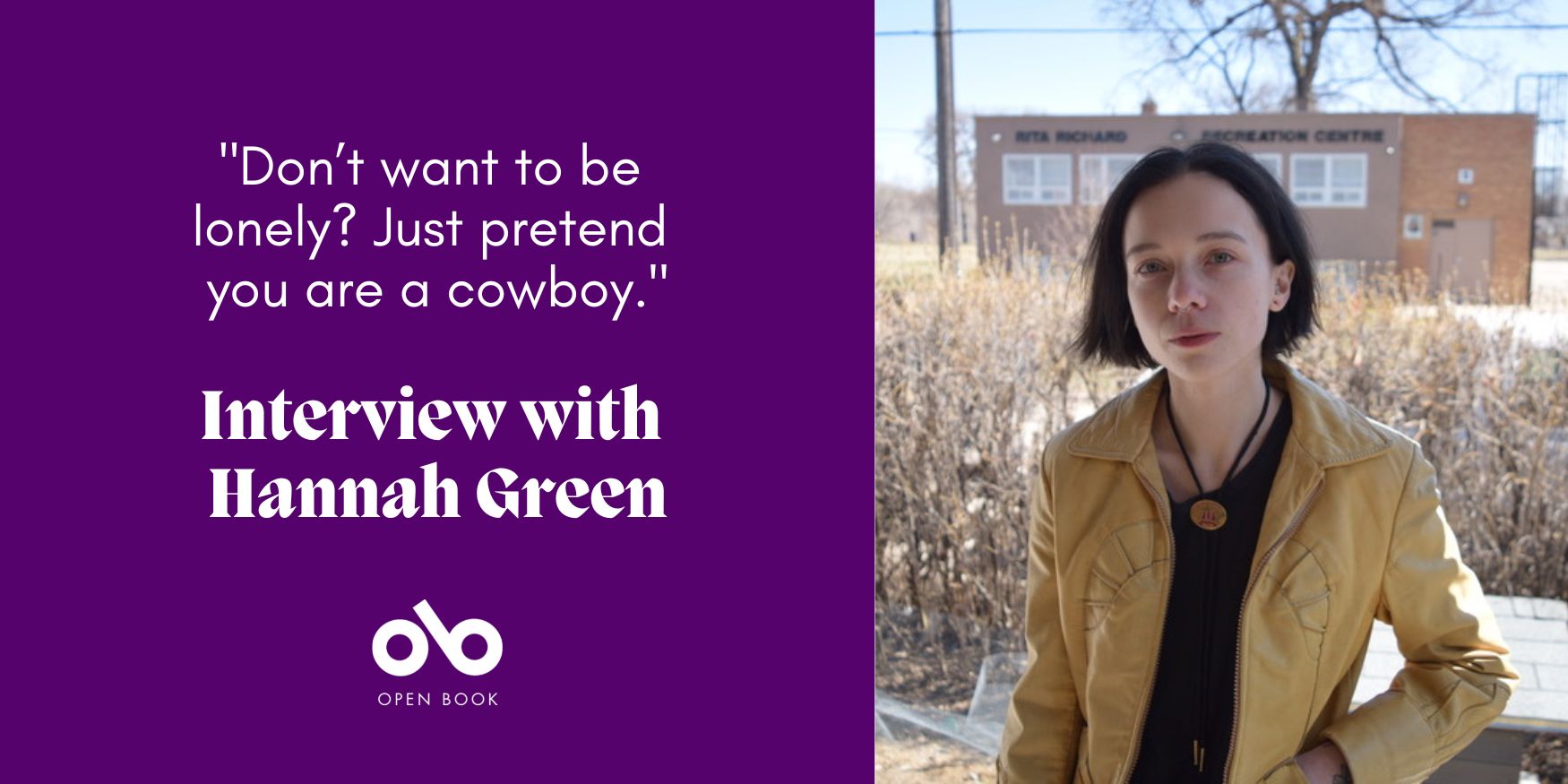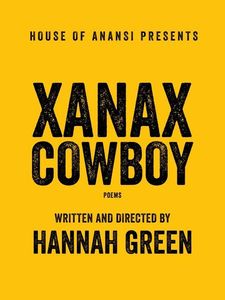"Raw and Real and Blunt" Hannah Green on Getting Sober & Her Semi-Autobiographical Long Poem, Xanax Cowboy
The long poem that is Hannah Green's electric Xanax Cowboy (forthcoming from House of Anansi Press in April) is like nothing most poetry readers have encountered. When an early version of the poem was nominated for the prestigious RBC Bronwen Wallace Award for poetry in 2021, the jury called it "a metapoetic romp... at once campy, dark, and gnawingly tender...challeng[ing] conventions of power, performance, gender, and genre."
Swagger, anxiety, and dark humour swirl together in Green's brilliant and unique debut, which uses western motifs and settings to explores isolation and mental health. The unforgettable voice of the Xanax Cowboy herself, who stands in as a fictionalized version of Green, is hypnotically compelling, with the cowboy pulling off classic tough, Eastwood-esque badassery while still peeling back raw layers of longing and fear. Whiskey-soaked, trigger-happy, and deadly, Xanax Cowboy is a formidable, fresh, memorable debut.
We're talking with Green today about the book and (of course) the cowboy. She tells us about what attracted her to the western setting ("just pretend you're a cowboy, they are meant to be alone"), how she paid homage to another great Canadian western-set poetry collection, Michael Ondaatje’s The Collected Works of Billy the Kid, and the massive impact getting sober had on the book and her writing life.
Open Book:
Tell us about this collection and how it came to be.
Hannah Green:
Xanax Cowboy is a long poem and the character telling the story. The collection is about loneliness and isolation, using the Wild West as a romantic backdrop.
Don’t want to be lonely? Just pretend you are a cowboy, they are meant to be alone.
The Wild West becomes a place for the Xanax Cowboy to escape to, where there are no pills that promise to cure the world we live in – away from modern medicine to a time when whiskey healed your wounds, because self-medicating is the one thing that seems to properly numb how she feels. The collection is about my own experience with illness and addiction.
Addiction takes a lot from you, and when active in it, you lie to yourself. You want everything to be fine, because you don’t think you can change. Xanax Cowboy is also about performance, all the layers that make and break us.
OB:
Was there any research involved in your writing process for these poems?
HG:
Yes! Researching Billy the Kid and the appeals of the Western, diagnoses through different eras, as well as those present today and the medications meant to soothe them, SEO, attention-seeking behaviour in women. Whew! That is a tangent-list, but those are many of the things I researched and which hug at the underbelly of this collection.
Your CanLit News
Subscribe to Open Book’s newsletter to get local book events, literary content, writing tips, and more in your inbox
Many of the more “research-heavy” poems didn’t make it into Xanax Cowboy, but I find myself revisiting them now, and looking at how I could create a second collection with the outtakes.
Some of my favourite poetry collections are long prose poems that combine research with personal experience. They are the toughest poems to write – raw and real and blunt. Skinned of metaphor, their nature is vulnerable. This style of writing demands rigorous attention, honesty, a mouth that speaks plainly and truthfully rather than teeth that tear at syntax.
OB:
Did you write poems individually and begin assembling this collection from stand-alone pieces, or did you write with a view to putting together a collection from the beginning?
HG:
I knew that Xanax Cowboy would be a long poem, but I didn’t know I would write as much as I did. I think I would have kept going, if I wasn’t given a deadline. It was a strange experience, to “finish” the book. It took around three years to write the collection, and I spent those years writing as that persona. The book is done but I don’t have closure with this character yet, so I find myself writing a sequel because I still have a lot of cowboy material.
OB:
What's more important in your opinion: the way a poem opens or the way it ends?
HG:
As a long poem, Xanax Cowboy sways all over the place, switching perspective, form, tactic, voice. A long poem in this style is fun (note: highly recommend 10/10). Xanax Cowboy doesn’t need to open and end like a “stand-alone” poem, whether it is the character or the collection, it is a little bit broken, a little bit lopsided. You can leave threads tangled for 20 pages. Poems speak to each other, pointing their pistols through the pages.
One poem ends with “Billy the Kid, maybe you are not so different from a diagnosis then” and the next poem is a questionnaire used to assess depression, with answers from Michael Ondaatje’s The Collected Works of Billy the Kid.
Another poem is an email exchange, and ends with the Xanax Cowboy writing that she wants to write a metaphor about a lasso being a noose, but doesn’t think she can, because of “what happened to the horses”. Shortly after, I follow with a list poem of metaphors using a lasso. The lasso is always restrictive or painful:
“one lasso is a halo of rope and dear god what a drunk and feisty angel.”
I should start a long poem support group, because the long poem is a support group. Hi, my name is Xanax Cowboy and I am a long poem. No matter where words are positioned, they need each other, across all pages. They speak to each other, telling their stories.
OB:
Is there’s an individual, specific speaker in any of these poems (whether yourself or a character)? Tell us a little about the perspective from which the poems are spoken.
HG:
From the first page, Xanax Cowboy is a joke the speaker tells herself. I know that I use humour in my poetry, and I think this is because a poet’s coping mechanisms in life can become the strategies it relies on in its writing.
Sometimes I tell stories to make people laugh, and they will tell me that what happened wasn’t funny. And hearing that can hurt. If I’m laughing I’m not crying.
I think that is why my speaker shields itself with humour. Xanax Cowboy allows me to distance what hurts, is painful, uncomfortable, and hard to look at, from my own life.
Xanax Cowboy is the speaker but also a character created to protect me. It gives me something to hide behind, not looking at my own life and mess, but the mess of the Xanax Cowboy in the room she lives in above a saloon.
Xanax Cowboy steps in, fully realized, and separate from me, at the most difficult times in the book. Eventually, the mechanism stops working. The second last poem is a movie that begins to fall apart. Set in the Wild West, the movie contains sections of my life “off set,” including parts of my medical record.
Xanax Cowboy, tells my life story using a persona, but when the narrative collapses, only I am left. I have been the Xanax Cowboy all along.
I am a Xanax Cowboy, and I am still here.
OB:
Was there a question or questions that you were exploring, consciously from the beginning or unconsciously and which becoming clear to you later, in this collection?
HG:
Not so much a question, but an answer. I got sober! I turned on the lights. I saw how even in my poetry I was defending my addiction. Trying to convince not only myself, but the reader that everything was alright. This still happens in the book, but sobriety allowed me to do this in a way I wouldn’t have been able to otherwise.
I mentioned it before but I’LL SAY IT AGAIN HERE – from the very first page, Xanax Cowboy announces herself to be a joke. I write:
“How like the poet. To rewrite its own tragedy into a comedy.
What is a joke but trauma bleeding from the back, stabbed with an exclamation mark?”
Announcing that everything is a joke is a defence of addiction. One I didn’t realize I was making until I got sober. If the container is a comedy, then how could its content be tragic?
It isn’t a funny story. Even though I try to make it one. Because if I’m laughing, then it doesn’t hurt. Because if I can make other people laugh, then I am controlling the narrative, then what happened wasn’t that bad.
When I got sober, I developed more awareness around the character I had created, how I use Xanax Cowboy as a mask to protect myself, when I was unable to admit that it was possible for me to change.
OB:
For you, is form freedom or constraint in poetry?
HG:
Freedom! Form is something to screw with and not be screwed over by. But I’m talking form as in medical questionnaires and email exchanges. I’m talking templates outside of poetry, and prying open the jaws to slip a little poetry in the mouth.
You’ll be surprised what gets spit out.
Without form, this collection wouldn’t move the way it does. It was fun. Playing with the forms that are ever-present in our modern life made sense to me, as I was telling Xanax Cowboy’s story. It made sense to include email exchanges, her experience with a meditation app, a list of symptoms.
Long poems are an amazing way to explore form. Character driven, you have the room to play around, without needing anything grand to happen. A long poem needs space to breathe.
Playing with form gives you that long inhale and exhale.
Xanax Cowboy is a character I live with, huddled on the balcony, we share a cigarette.
______________________________________________
Hannah Green is a writer and poetry editor at CV2. She was a poetry finalist for the 2021 Bronwen Wallace Award for Emerging Writers. She lives in Winnipeg.





